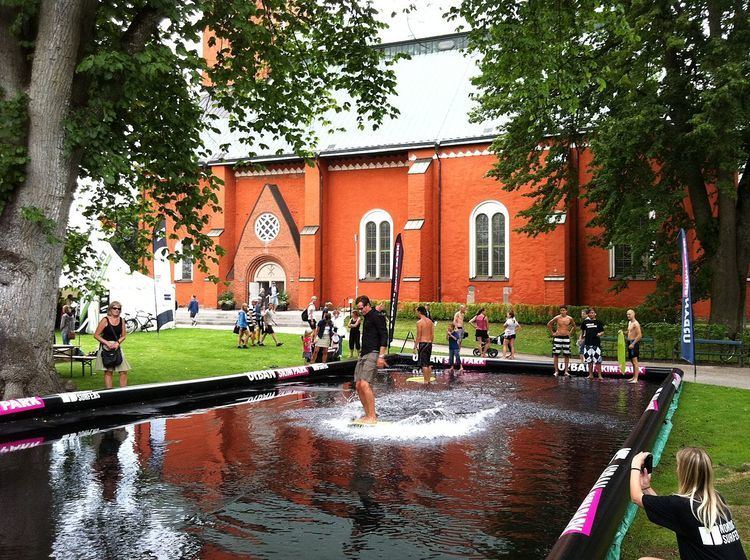 | ||
Flatland skimboarding (also known as inland skimboarding) is a form of skimboarding practiced on non-coastal waters, such as a river, lake, stream or puddle. It uses a wooden board about three times as wide as a skateboard and one and a half times as long. The board is thrown across a thin film of water. While the board is still moving the rider jumps on and skims across the water to do what ever tricks he or she can imagine.
Contents
History
Inland skimboarding emerged in the mid 1970s and has its roots in Sacramento, California. With homemade skimboards made of plywood, fiberglass and resin, skimmers were sliding on sandbars along the American and Sacramento rivers. Most skimmers back then were just doing headstands, multi-360 spins and 180 shuvits for tricks.
The freestyle aspects of inland skimboarding were pioneered in the early 1980s by two Sacramento locals: Launie Porteous and Mark Robinson. Influenced by the emerging skateboard scene, Launie and Mark started adapting their newfound skateboarding skills to skimboarding and the concept of freestyle skimboarding was born. This freestyle adaptation has led to what is now considered the true definition of this sport.
With the evolution of the Ollie on a skimboard, it allowed skimmers to transcend into olling over obstacles and opened up the doors for more technical tricks. Riding up the side of a wet river bank and coming back down to simulate a 1/4 pipe was also a new trick. Skimmers also propped up skimboards or wood planks on logs creating a ramp to jump off and do more tricks.
In the late 80's, skimmers advanced to building better rails and jumps and adapting more technical skateboard tricks, but they still used stuff found around their environment like shopping carts, road cones, trash cans, etc. to use for obstacles.
The 90's is where inland skimboarding started to really take hold as a cult sport. Utah was next to have an inland skimboard scene that was actually influenced by Sacramento skimmers that transplanted there. Come the late 90's, inland skimboarding had steadily grown and had emerged in other US cities and in Canada and Australia.
As of today, Canada has the largest number of participants of flatland skimmers; they can't be referred to as inland skimmers because they skim on the coast, but their style of skimboarding is the same as inland skimboarding. Australia also has a large coastal flatland skimboard scene. Flatland and inland skimboarding has also taken hold in various European countries.
Differences from other boardsports
Flatland skimboarding can be done in almost every region of the world as it only requires a shallow pool of water which can be found in oceans lakes and even flooded fields. Riding rails in flatland skimming is unique in that you can combine snowboarding and skateboarding tricks into one. Without trucks to prevent the rider from spinning creates many variations and combinations of tricks when combining it with the non-binding skateboard tricks such as big-spins and pop shuv-its.
Boards
In late 1970s and early 80s, companies such as J-Gordon and Victoria manufactured wood skimboards for local California surf and skateboard shops. For the first time inland shops like GoSkate of Sacramento offered skimboards to the local crowd. Shortly thereafter, Surf&Skate in Sacramento also got involved with offering boards to the emerging skim scene.
Before the availability of production-made boards, inland skimmers just made their own wood boards from scratch. The boards back then were a classic tear-drop or tombstone shape. Current designs and constructions have not changed much, but the new shape preference for most inland skimmers is a twin-tip or symmetrical shaped board.
The problems encountered with inland skimboarding are the countless rocks, sticks, logs, clam shells, railsliders, run-away boards, etc. These obstacles will eventually destroy any foam constructed board, so wood is still the preferred material of choice for most inland skimmers.
Tricks
There are an unlimited number of tricks that can be performed while skimboarding. This list only covers a small chunk of the tricks possible. As with other board sports, riders seek out or invent new tricks to progress the sport.
Ollies
Flip Tricks
Spins
Shuv-Its
Body Varials
Contests
The first ever inland skimboard event and competition was put on by GoSkate skate shop in 1985 at a skim spot named Rio located along the American River in Sacramento, California. The second inland skimboard event, Skim Fest, occurred in 1997 and was also held in Sacramento along the American River at a popular skim spot known as Paradise Beach. Skim Fest was created by skim pioneers Launie Porteous and Mark Robinson and the event has evolved into an annual competition since 1998 to present. It now holds the title as the longest running inland skim competition in the world.
